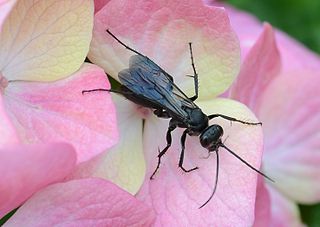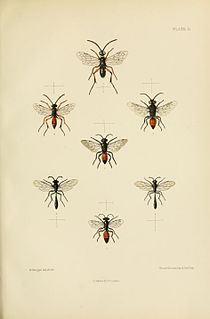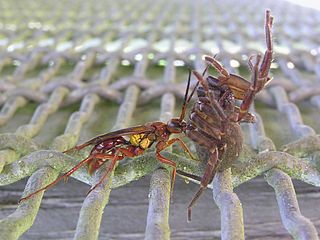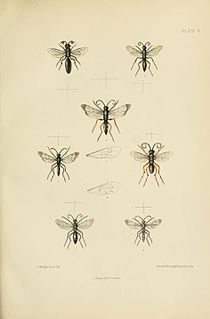
The Ichneumonidae, also known as the ichneumon wasps or ichneumonids, is a parasitoid wasp family within the insect order Hymenoptera. This insect family is among the most species-rich branches of the tree of life. At the same time, it is one of the groups for which our knowledge most severely lags behind their actual diversity. The roughly 25,000 species described today probably represent less than a quarter of their true richness, but reliable estimates are lacking, as is much of the most basic knowledge about their ecology, distribution and evolution. Ichneumonid wasps, with very few exceptions, attack the immature stages of holometabolous insects and spiders, eventually killing their hosts. They thus fulfill an important role as regulators of insect populations, both in natural and semi-natural systems, making them promising agents for biological control.

Ant mimicry or myrmecomorphy is mimicry of ants by other organisms. Ants are abundant all over the world, and potential predators that rely on vision to identify their prey, such as birds and wasps, normally avoid them, because they are either unpalatable or aggressive. Spiders are the most common ant mimics. Additionally, some arthropods mimic ants to escape predation, while others mimic ants anatomically and behaviourally to hunt ants in aggressive mimicry. Ant mimicry has existed almost as long as ants themselves, the earliest ant mimics in the fossil record appear in the mid Cretaceous alongside the earliest ants. Indeed one of the earliest, Burmomyra was initially classified as an ant.

Dipogon subintermedius is a spider wasp from the family Pompilidae.
Cryptocheilus notatus is the largest species of spider wasps (Pompilidae) to be found in Great Britain reaching up to 18mm in length.

Anoplius nigerrimus is one of the most common spider wasps, or pompilids, in Europe. They are mostly black and the females are 6-8 mm long while males measure 5-8 mm. This species may be distinguished from the related Anoplius concinnus and Anoplius caviventris by the 20 setae, or hairs, on the forehead rather than 60 or 45.

Ceropales maculata is a kleptoparasitic spider wasp found in the holoarctic region.

Priocnemis monachus is a large spider wasp from New Zealand where it is known as the "black hunting wasp". It is the largest pompilid in New Zealand.

Sphictostethus nitidus, the golden hunter wasp or red spider wasp, is a species of pepsid spider wasp endemic to New Zealand.
Evagetes crassicornis is a kleptoparasitic spider wasp with a holarctic distribution.
Arachnospila anceps is one of the more common spider wasps of western Europe.

Arachnospila trivialis is a widespread spider wasp of sandy soil areas of the Palaearctic.

Agenioideus cinctellus is a spider wasp of the subfamily Pompilinae with a Palearctic distribution.
Priocnemis coriacea is a large species of pepsid spider wasp characterised by having plentiful erect hair on the face and propodeum. It is a member of the subgenus Umbripennis.
Priocnemis susterai is a large species of pepsid spider wasp and is, with Priocnemis perturbator and Priocnemis coriacea, one of three similar species of the subgenus Umbripennis found in Great Britain. All three of these species are characterised by having plentiful erect hair on the face and propodum.

Cantuaria dendyi is a species of trapdoor spider in the family Idiopidae. It can be found in the South Island of New Zealand and is limited to the Christchurch and Banks Peninsula area.

Anoplius viaticus, commonly known as the black-banded spider wasp, is a species of spider wasp. These wasps are known as spider wasps because the females capture spiders to provide their offspring with food. The paralysed spider is cached in a burrow, the wasp lays an egg on it, and when this hatches, the developing wasp larva consumes the spider. This species is found in sandy heathland across most of Europe.

Trochosa terricola is known as the ground wolf spider, is a wolf spider which is common and widespread in western and central Europe. It has been recorded as prey for the pompilid wasp.

Tetragnatha montana, commonly known as the silver stretch spider, is a species of long-jawed orb weaver from the family Tetragnathidae that has a Palearctic distribution. It preys mostly on flies and mosquitoes. The name silver stretch spider refers to its shiny metallic colour and its habit of extending its legs into a stick like shape.

Pison spinolae, commonly known as mason wasp, is a solitary wasp of the family Crabronidae, found throughout New Zealand.














